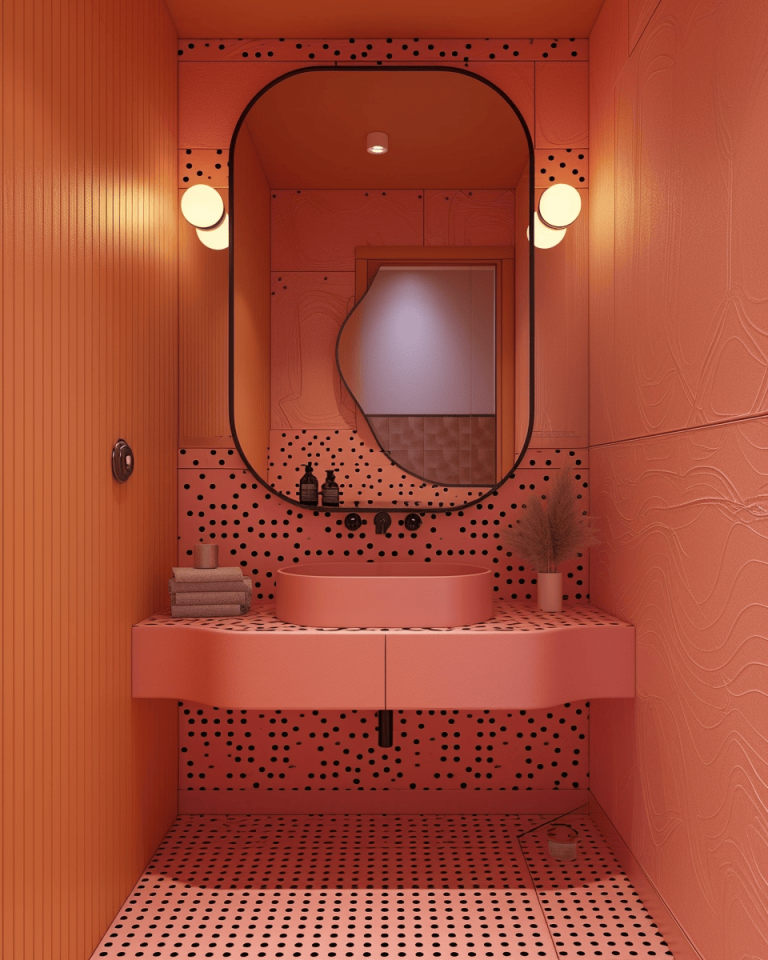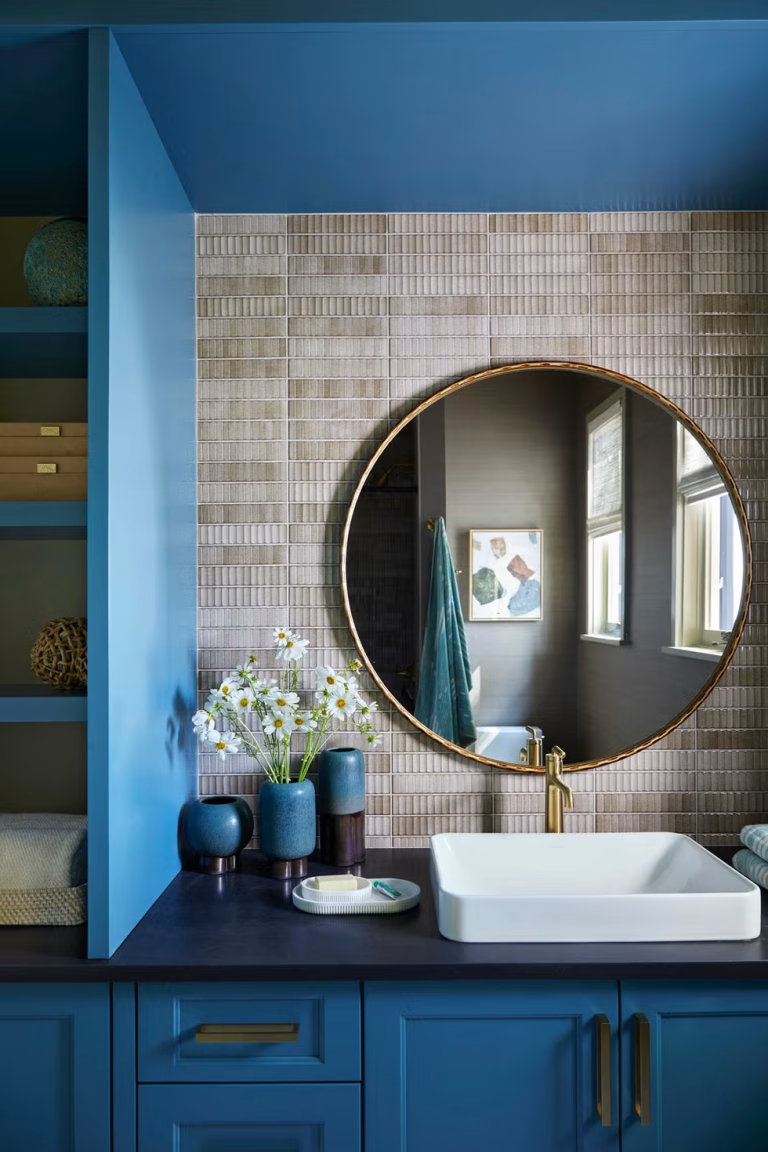17 Japandi Kitchen Design Ideas for Small Spaces
Japandi style—a beautiful blend of Japanese minimalism and Scandinavian functionality—is a perfect choice for small kitchens. It balances simplicity, natural elements, and practical design, making even the tiniest kitchen feel spacious, serene, and stylish. If you’re dreaming of a modern kitchen that feels calm, organized, and inviting, Japandi is the way to go.
In this article, you’ll discover 17 Japandi kitchen design ideas tailored specifically for small spaces. These ideas focus on clever layouts, natural materials, and thoughtful decor that enhance your kitchen’s usability while bringing a soothing, timeless aesthetic. Let’s dive in!
1. Embrace Natural Wood Tones
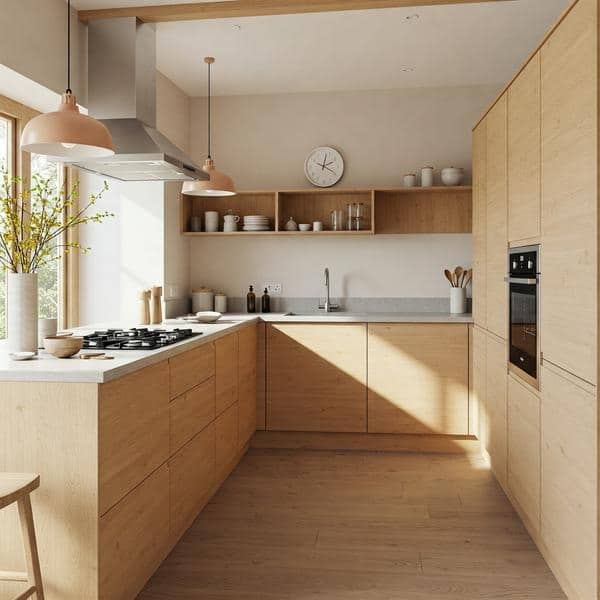
One of the defining characteristics of Japandi style is its deep love for natural wood. Using light to medium wood tones in cabinetry, countertops, or flooring adds warmth without overpowering the space. In a small kitchen, natural wood can make the room feel cozier and connected to nature, which is a key principle in Japandi design.
To avoid making the kitchen look cluttered, stick with clean-lined, simple wooden cabinetry that has minimal detailing. Opt for finishes that highlight the wood’s grain to emphasize its natural beauty. Combining these wooden elements with neutral walls and countertops helps create a balanced, airy feel.
Natural wood also pairs wonderfully with muted greens or soft whites, colors that echo the calm simplicity of Japanese interiors and Scandinavian palettes. This combination invites tranquility while keeping the kitchen light and bright, perfect for small spaces.
2. Utilize Open Shelving with Bamboo Accents
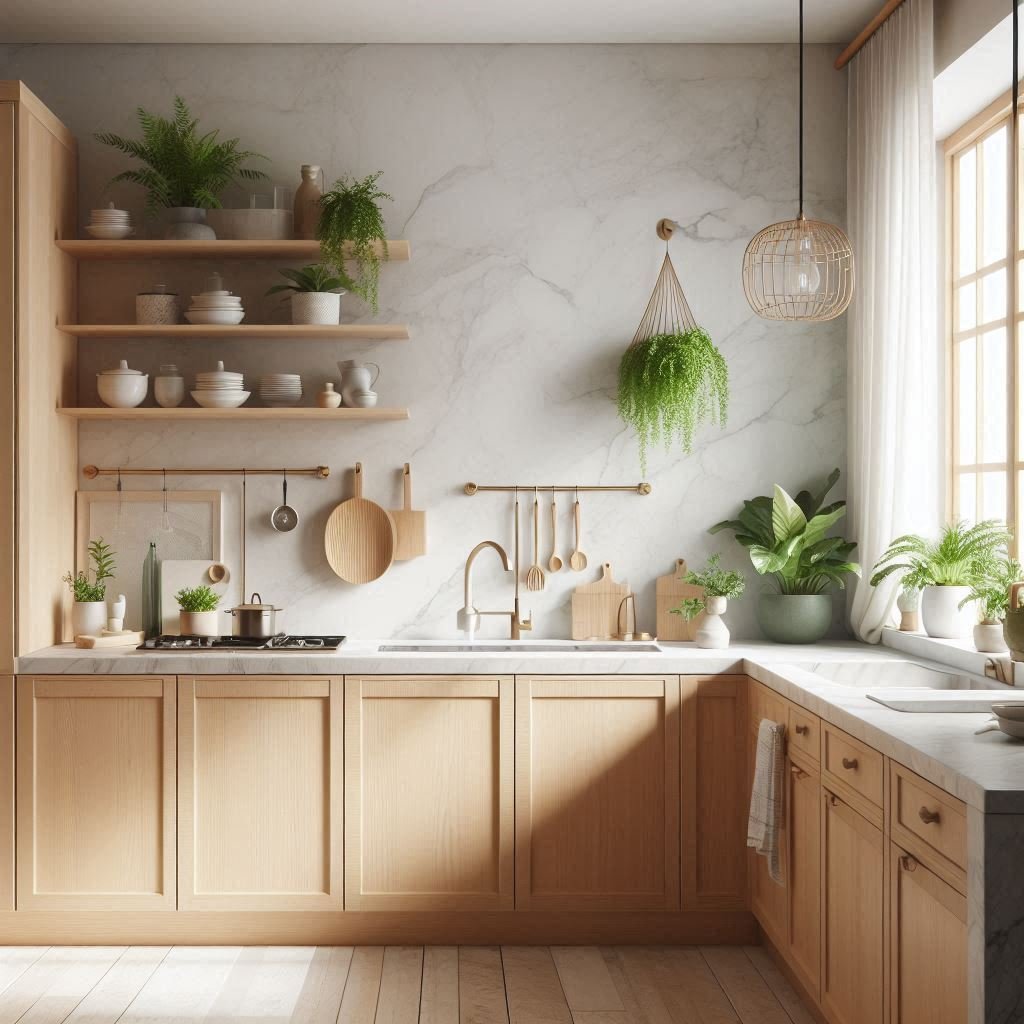
Open shelving is a smart choice for small kitchens, as it opens up the visual space and keeps your essentials within easy reach. In Japandi design, open shelves are typically crafted from natural materials like bamboo or light wood to maintain that organic, earthy vibe.
Bamboo shelves add texture and warmth, and their sleek yet sturdy appearance aligns with the minimalist approach of Japandi style. Use these shelves to display simple, beautiful ceramics, glassware, or wood utensils. Avoid overcrowding; instead, let each item have its own space to breathe, enhancing the minimalist feel.
Moreover, open shelving encourages keeping your kitchen tidy and organized—perfect for a small space where clutter can quickly overwhelm. It also allows you to showcase your personality subtly through carefully curated decor, blending functionality with art.
3. Incorporate Matte Black Fixtures
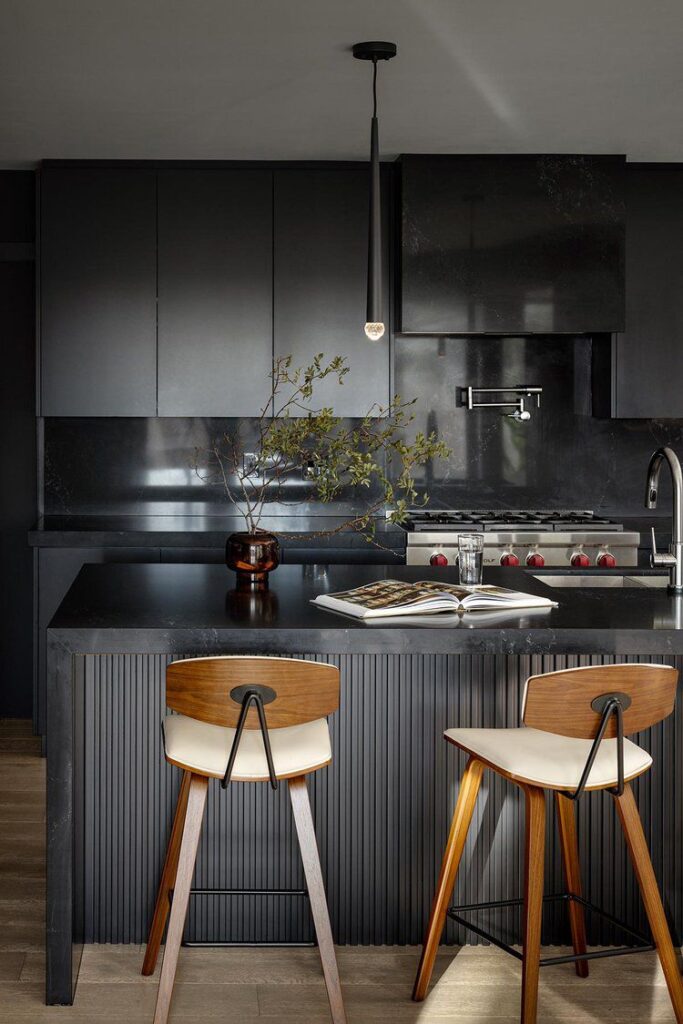
Matte black fixtures and hardware bring a touch of modern elegance to a Japandi kitchen. In small spaces, these dark accents create striking contrasts against lighter woods and neutral tones, adding depth and visual interest without feeling heavy.
Think matte black faucets, cabinet handles, and pendant lights. These fixtures are sleek, understated, and versatile, complementing the natural and minimalist aesthetic beautifully.
Besides aesthetics, matte black hardware is practical—it tends to hide fingerprints and water spots better than shiny finishes, keeping your kitchen looking cleaner with less effort. The simplicity of these fixtures ensures they won’t overwhelm a small kitchen’s design but will add that subtle touch of sophistication.
4. Opt for Minimalist Cabinetry
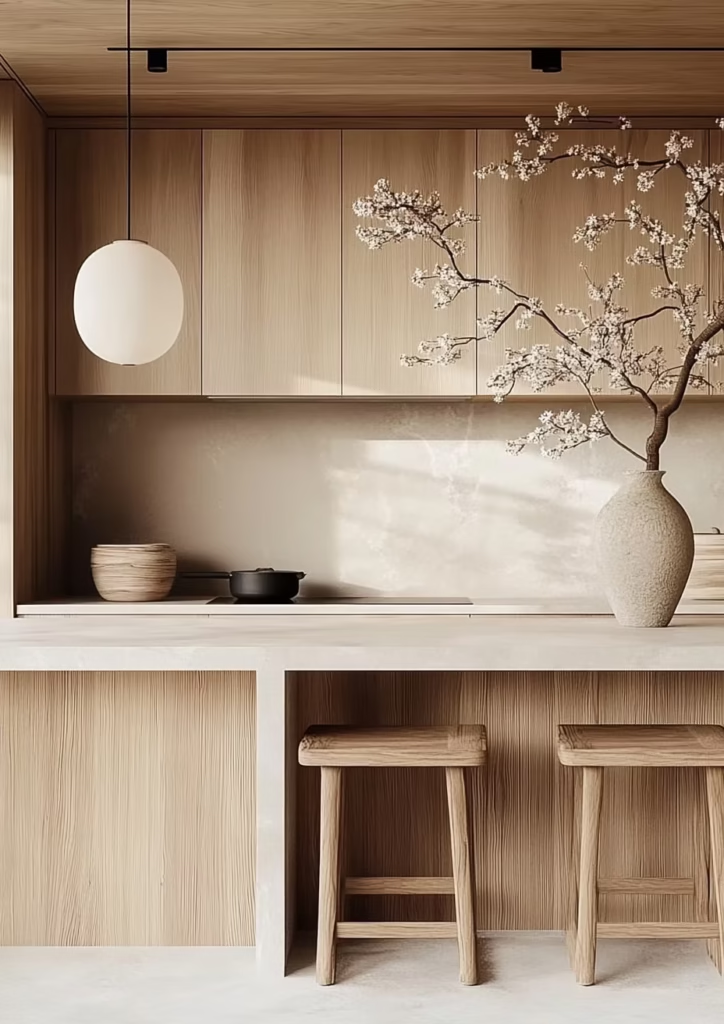
Cabinetry in Japandi kitchens is all about clean lines and functional simplicity. Avoid ornate details, heavy moldings, or flashy finishes. Instead, choose flat-panel cabinets with integrated handles or push-to-open mechanisms that maintain the smooth, uncluttered look.
Minimalist cabinetry visually expands the kitchen by reducing distractions and promoting a seamless flow. In small spaces, every inch counts, so cabinets should be both beautiful and highly functional.
Light wood tones, soft matte finishes, or muted colors like soft gray or off-white are excellent choices for cabinetry, as they reflect light and enhance the airy feel typical of Japandi interiors. When paired with natural wood countertops or bamboo accessories, these cabinets bring harmony to the space.
5. Use Neutral Color Palettes with Earthy Accents

Japandi style thrives on soothing, neutral color palettes punctuated with earthy accents. For a small kitchen, this means focusing on whites, beiges, soft grays, and natural wood tones to create an open and calming atmosphere.
Accents of muted greens, soft browns, or even gentle blues can be incorporated through kitchen textiles, plants, or small decor pieces. These touches mimic nature, grounding the space and bringing a sense of balance.
Avoid bright or overly saturated colors that can make the kitchen feel cramped or chaotic. Instead, choose colors that enhance the minimalist and nature-inspired theme, helping your small kitchen appear more spacious and serene.
6. Integrate Smart Storage Solutions
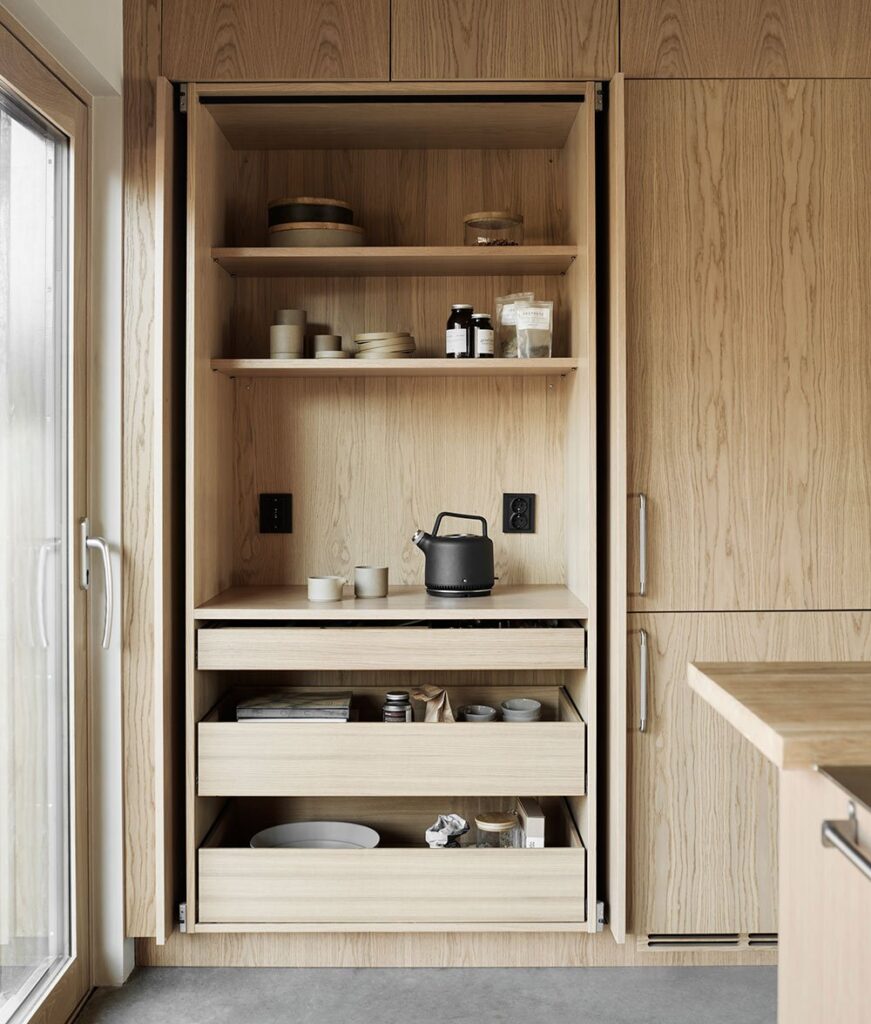
Storage is a crucial factor in small kitchens. Japandi design emphasizes not just beauty but also function, so smart storage is a must-have. Think pull-out pantry shelves, under-sink organizers, and deep drawers for pots and pans that maximize every inch of available space.
Integrating hidden storage options—like toe-kick drawers or cabinets that reach up to the ceiling—maintains the kitchen’s clean aesthetic while keeping clutter out of sight.
A clutter-free kitchen not only looks bigger but also feels more peaceful, aligning perfectly with Japandi’s minimalist ethos. Efficient storage solutions ensure your kitchen remains both practical and beautifully organized.
7. Choose Simple, Functional Lighting

Lighting in a Japandi kitchen should be unobtrusive yet highly functional. Simple pendant lights with clean lines or understated ceiling fixtures work best in small spaces. Natural materials like paper, wood, or metal with matte finishes complement the overall design and add warmth.
Lighting should be layered: general ambient lighting combined with task lighting over work areas ensures your kitchen is both practical and cozy.
Avoid overly decorative or bulky light fixtures that dominate the space. Instead, focus on designs that blend seamlessly with the minimalist style while providing ample illumination for cooking and dining.
8. Incorporate Natural Textures and Materials

Texture plays a big role in Japandi kitchens. To keep a small kitchen interesting without overcrowding, introduce subtle textures through natural materials such as woven rattan baskets, linen curtains, stone countertops, or ceramic dishes.
These elements add depth and tactile appeal while maintaining the calm, earthy vibe of Japandi design. For example, a linen runner on a small dining table or woven baskets for produce storage add warmth and softness.
Natural textures also reinforce the connection to nature—a cornerstone of Japandi style—making the kitchen feel more inviting and grounded.
9. Use Compact Appliances with Clean Designs
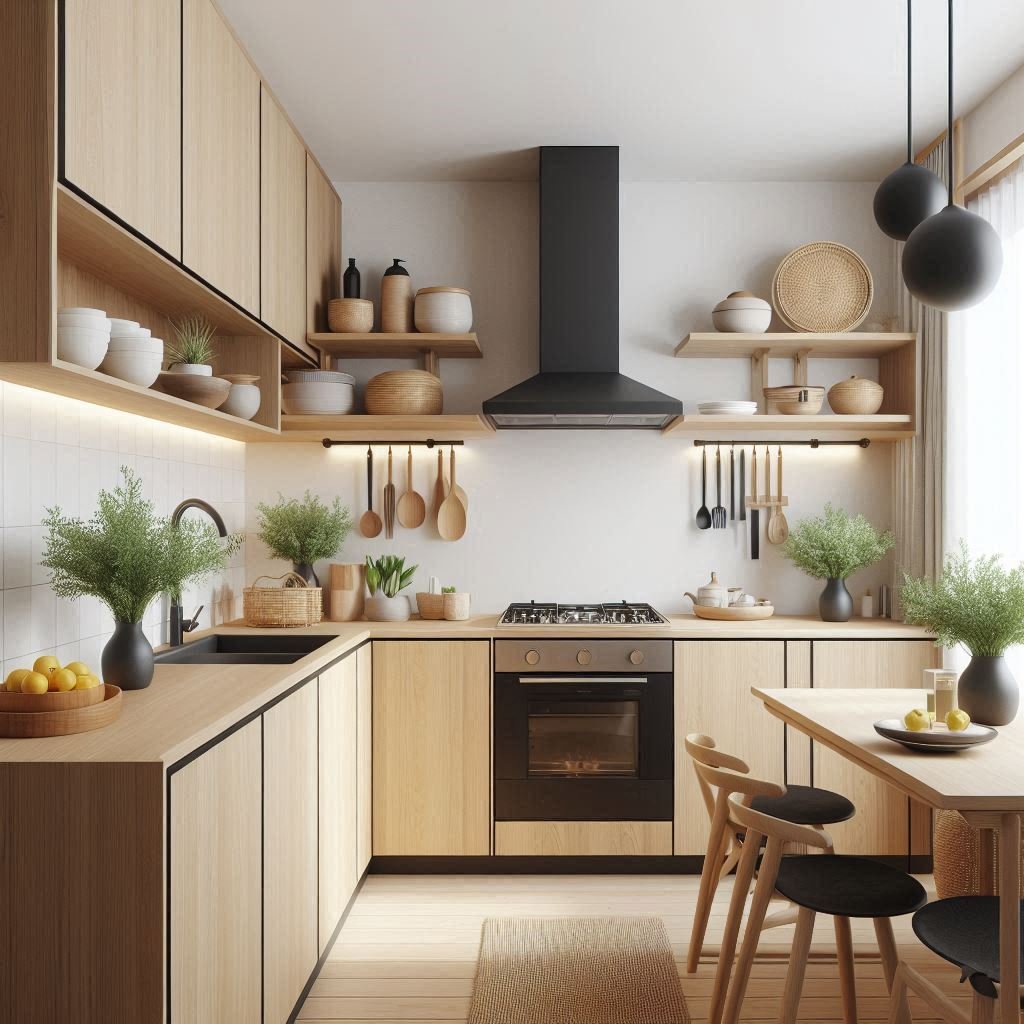
In small Japandi kitchens, appliances need to be compact but visually harmonious with the overall design. Look for sleek, minimalist appliances in neutral tones like white, black, or stainless steel.
Compact appliances save valuable counter space, helping maintain a clean and uncluttered look. Avoid bulky or overly complicated machines that detract from the kitchen’s serene feel.
Choosing appliances with simple shapes and minimal buttons or displays complements the Japandi philosophy of understated elegance and functionality.
10. Incorporate Sliding or Pocket Doors
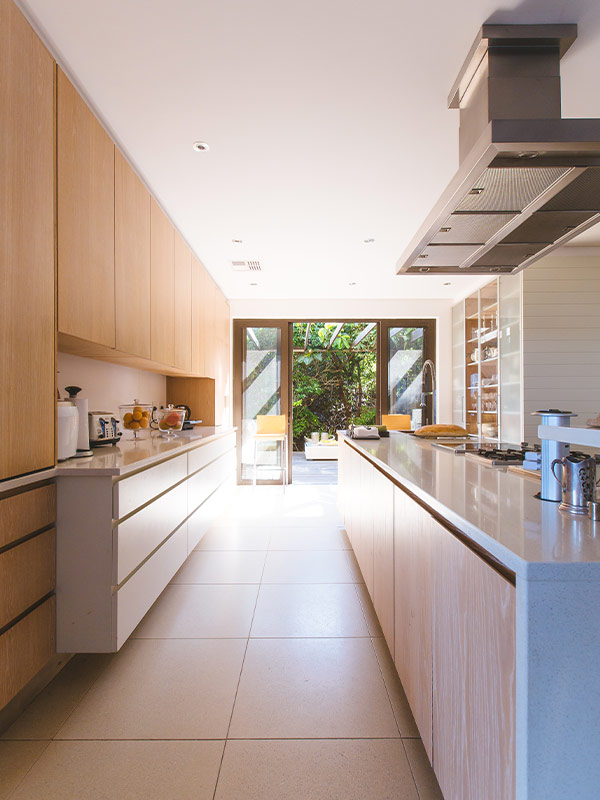
Sliding or pocket doors are a fantastic solution for small kitchens aiming to maintain a clean, open flow. Traditional swinging doors take up valuable space, but sliding options glide effortlessly along a track, saving every precious inch.
In Japandi design, these doors often feature natural wood frames with paper or glass panels, inspired by Japanese shoji screens. They not only enhance the aesthetic with their simple elegance but also allow natural light to filter through, keeping the kitchen bright and airy.
By using sliding doors, you maintain the minimalist vibe while cleverly adapting your kitchen’s layout to fit the constraints of a smaller footprint.
11. Add Indoor Plants for a Touch of Greenery
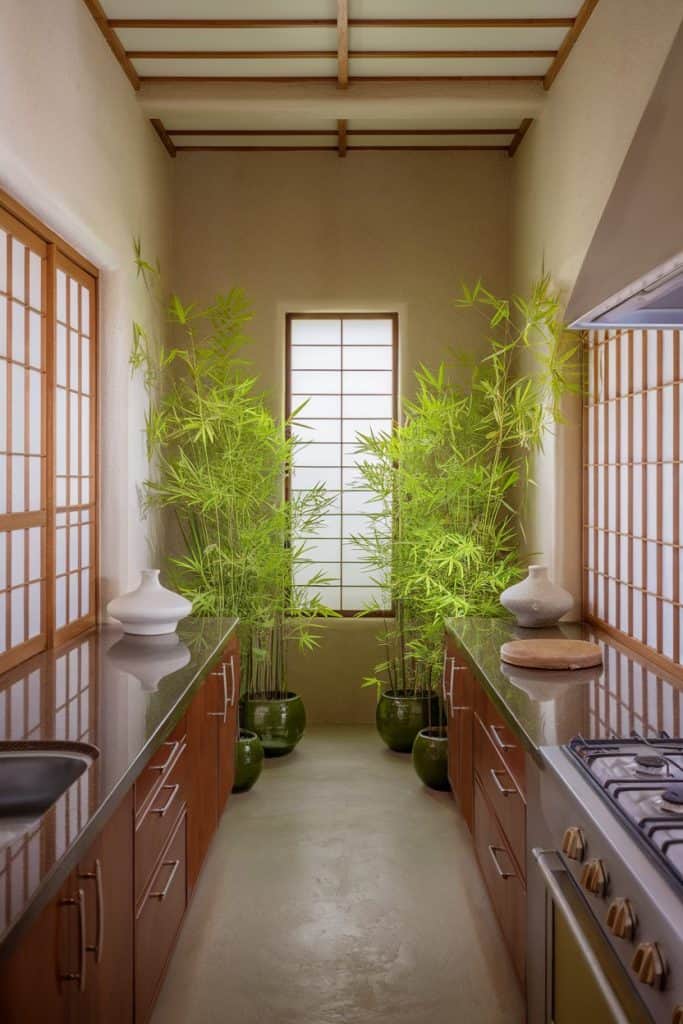
Nothing breathes life into a Japandi kitchen like greenery. Small potted plants, succulents, or even a simple herb garden on the windowsill introduce natural color and vitality without overwhelming the space.
Plants reinforce Japandi’s focus on nature and well-being, improving air quality and creating a calming atmosphere. Choose plants with simple, clean lines—like snake plants, pothos, or bonsai—that complement the minimalist aesthetic.
Arranging plants thoughtfully—either on open shelves, countertops, or hanging planters—adds texture and interest while softening the kitchen’s geometric lines.
12. Opt for Multipurpose Furniture

In a small kitchen, furniture that serves more than one purpose is invaluable. Consider a compact kitchen island that doubles as a dining table or extra storage, or stools that tuck neatly under counters.
Japandi style values functionality and simplicity, so choose pieces with clean lines and natural materials such as light wood or bamboo. Multipurpose furniture keeps your kitchen uncluttered and adaptable for cooking, dining, and socializing.
This practical approach not only saves space but also encourages a lifestyle that appreciates intentional, mindful living—core to the Japandi philosophy.
13. Use Subtle Patterns with Natural Motifs

While Japandi leans heavily on simplicity, subtle patterns inspired by nature can add quiet charm to your small kitchen. Think delicate leaf prints on tea towels, geometric motifs reminiscent of traditional Japanese design, or Scandinavian-inspired textiles.
Incorporate these patterns sparingly to maintain the minimalist look, perhaps in a rug, curtains, or cushions on kitchen seating. Soft, muted colors keep the patterns from becoming distracting or busy.
These gentle design elements add personality and warmth without compromising the clean, serene atmosphere vital in small Japandi kitchens.
14. Integrate Seamless Countertops and Backsplashes
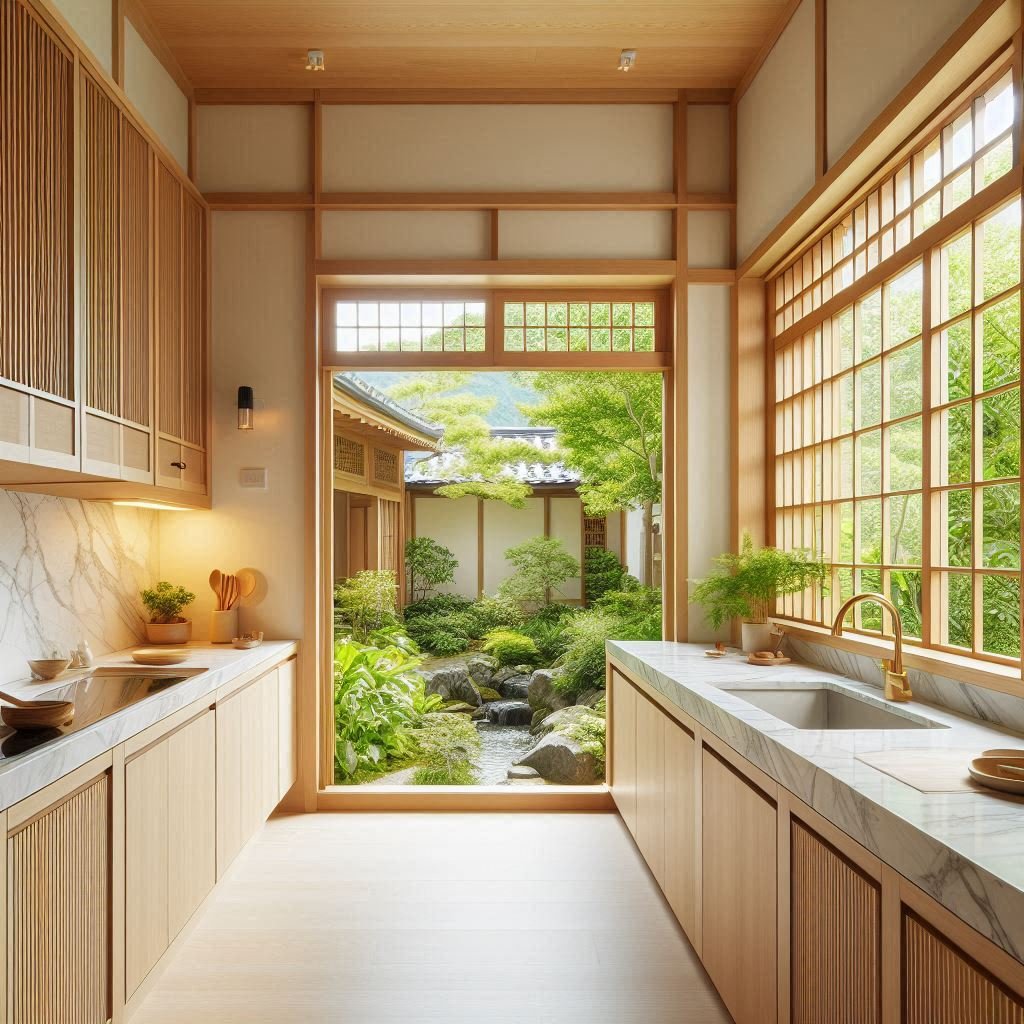
Creating seamless surfaces in your kitchen helps amplify the sense of space and cleanliness. Choose countertops and backsplashes made from natural stone, quartz, or concrete in neutral shades that blend effortlessly.
Avoid busy patterns or overly shiny finishes that can visually break up the space. Instead, smooth, matte surfaces with subtle veining or texture bring understated elegance.
This approach not only enhances hygiene and easy maintenance but also strengthens the harmonious, uncluttered aesthetic of Japandi design.
15. Emphasize Horizontal Lines
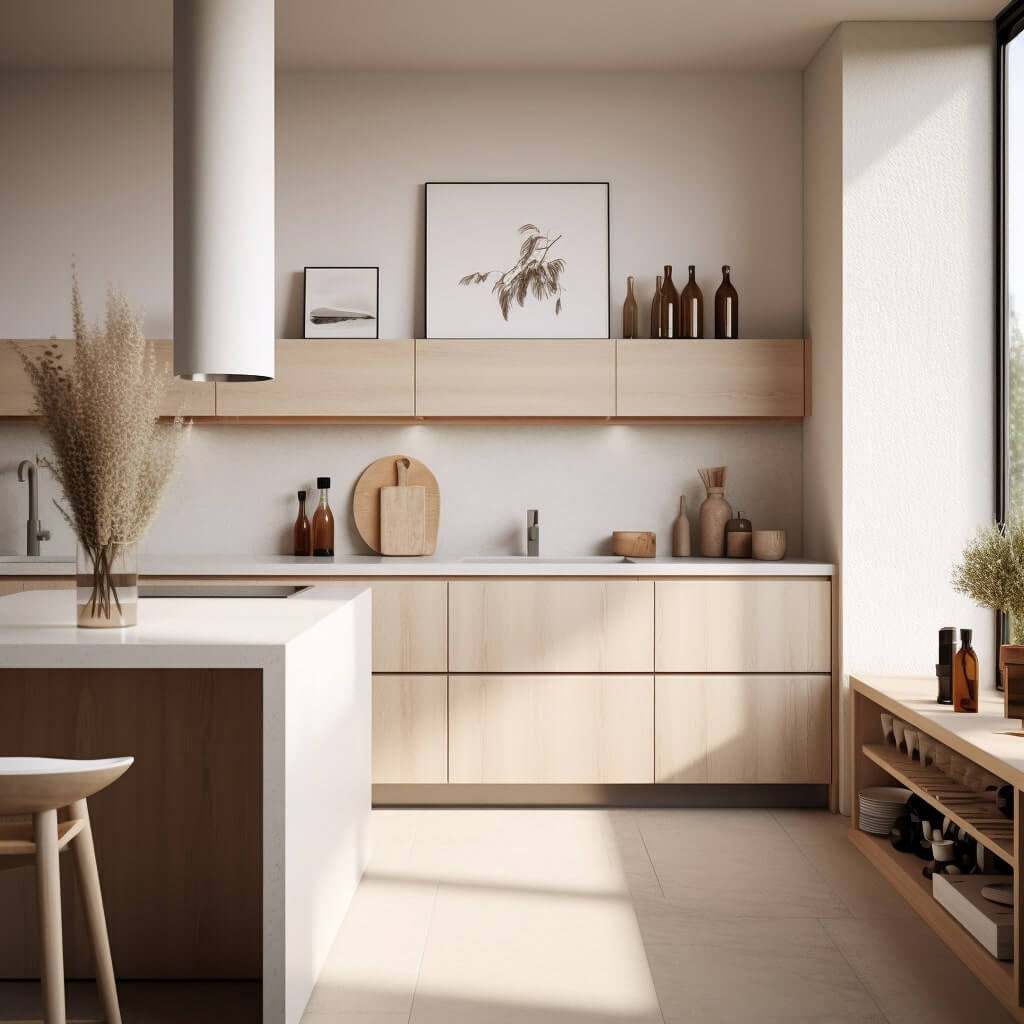
Horizontal lines create a feeling of calm and stability—perfect for the tranquil Japandi kitchen. Use long, low cabinets, open shelves, or bench-style seating to emphasize horizontal elements.
This technique helps visually widen a small kitchen, making it feel more expansive. Horizontal grain in wood cabinetry or flooring also enhances the natural, organic vibe of the space.
By deliberately focusing on horizontal design, you maintain Japandi’s minimalist principles while cleverly playing with spatial perception.
16. Add Textured Ceramic or Stoneware Accessories
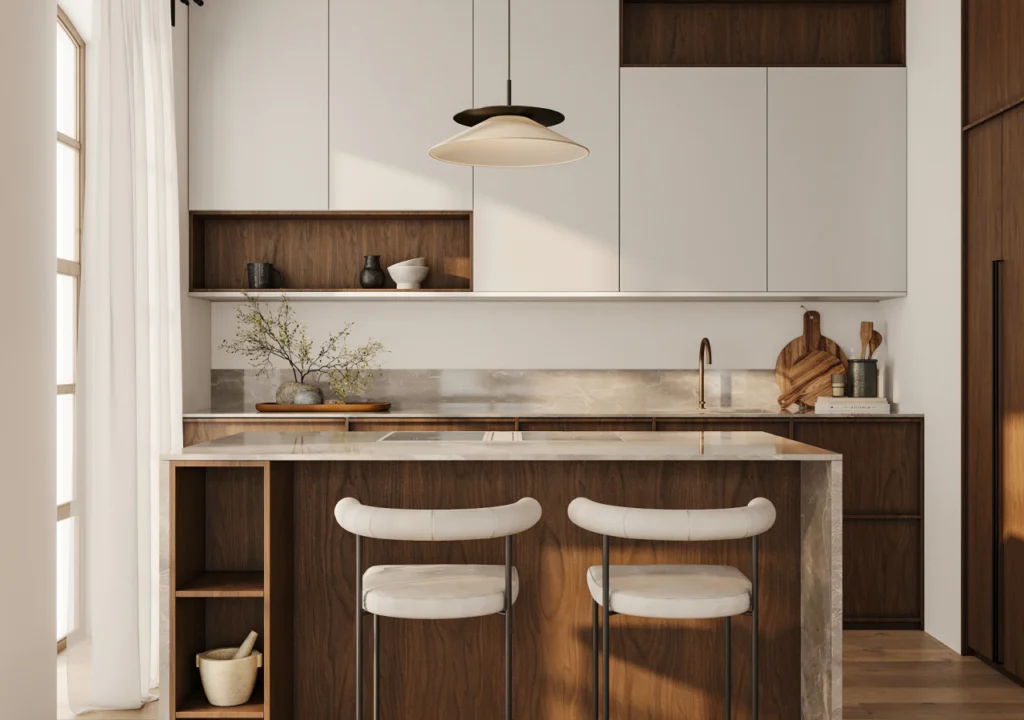
Textured ceramics and stoneware bring a tactile, artisanal touch to a Japandi kitchen. Handcrafted bowls, plates, or pitchers in muted earth tones offer visual interest and warmth.
These pieces reflect the wabi-sabi philosophy, which celebrates imperfection and the beauty of natural materials. Using such accessories encourages slow living and mindful appreciation in your kitchen routine.
Display a few select items on open shelves or countertops to enhance the kitchen’s personality without cluttering the space.
17. Keep Clutter to a Minimum with Thoughtful Decor
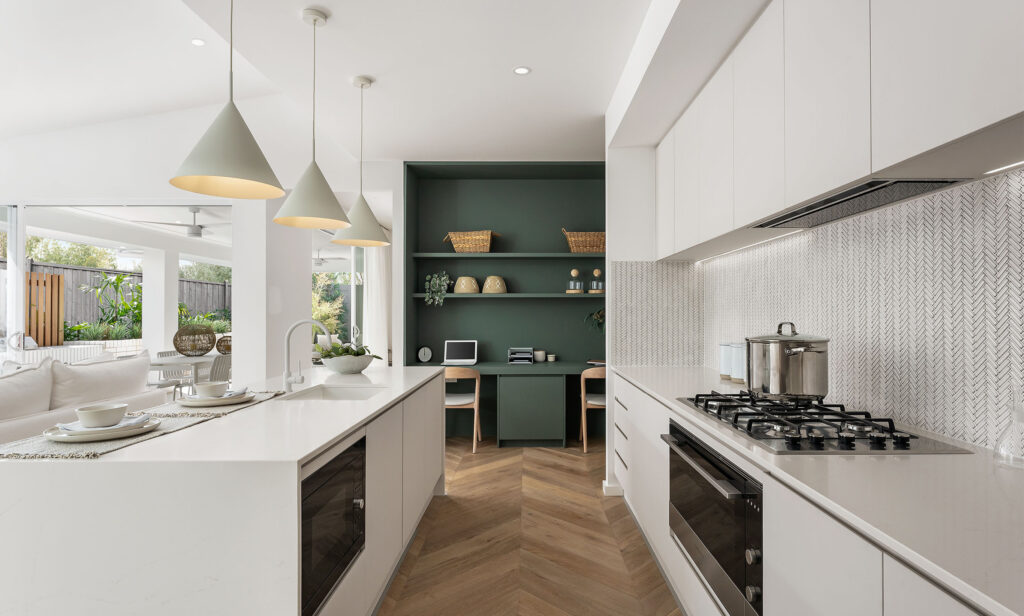
The essence of Japandi style is simplicity, so keeping clutter minimal is essential. Choose decor that serves a purpose or brings joy, and avoid overcrowding surfaces.
Invest in beautiful, practical storage containers and baskets that blend with your kitchen’s natural materials. Maintain open spaces and clear countertops to allow the kitchen’s design and natural elements to shine.
Minimal decor paired with intentional storage cultivates a serene environment that feels larger, calmer, and more inviting—a true Japandi hallmark.
Conclusion: Creating Your Serene Japandi Kitchen Sanctuary
Designing a Japandi kitchen in a small space is all about balance: blending the warmth and natural beauty of Japanese design with the clean, functional simplicity of Scandinavian style. By embracing natural wood tones, muted color palettes, smart storage, and minimalist fixtures, you create a kitchen that feels open, calm, and inviting—even if every square foot counts.
The 17 ideas shared here—from open bamboo shelving to sliding doors and textured ceramics—offer practical and aesthetic solutions that transform small kitchens into peaceful havens. This style encourages mindful living, where every detail has purpose and every material connects you to nature.
If you’re ready to make your small kitchen a serene retreat that’s both functional and beautiful, Japandi is the perfect design direction. With thoughtful planning and these inspired ideas, your kitchen will be a space you love to cook, gather, and unwind in for years to come.


